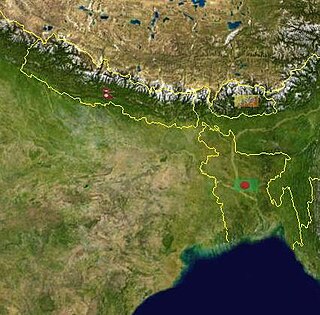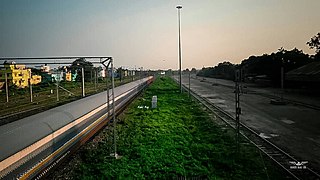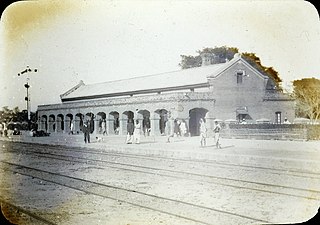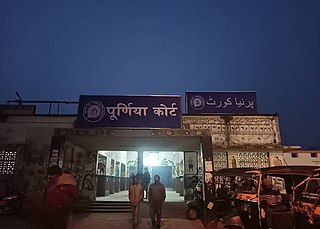Madhepura is a municipality in Madhepura district in the Indian state of Bihar. It stands at the centre of Kosi ravine, It was called Madhyapura- a place centrally situated which was subsequently transformed as Madhipura into present Madhepura. It is surrounded by Araria and Supaul districts in the north, Khagaria and Bhagalpur districts in the south, Purnia district in the east and Saharsa district in the West.

Purnia is the fourth largest city of Bihar and is emerging as the largest economic hub in North Bihar. It serves as the administrative headquarters of both Purnia district and Purnia division in the Indian state of Bihar. It is well known for its favourable climate like Darjeeling and has an abundance of resources for human settlements and economic activities.

Saharsa is a city and municipal corporation in the Saharsa District in the eastern part of the state of Bihar, India. It is situated near the eastern banks of the Kosi River. It serves as the administrative headquarters for the Saharsa District and is also the Divisional headquarters of the Kosi Division.
Supaul is a town and a municipality that is headquarters of Supaul district in the Indian state of Bihar. Supaul is the administrative headquarters of this district. There Are 11 block under the Supaul district Supaul, Kishanpur, Saraigarh-Bhaptiyahi, Pipra, Triveniganj, Raghopur, chhatapur, Nirmali, Marauna, Basantpur and pratapganj.

The East Central Railway is one of the 19 railway zones in India. It is headquartered at Hajipur and comprises Sonpur, Samastipur, Danapur, Pt. Deen Dayal Upadhyaya, and Dhanbad divisions.

Bihar is located in the eastern region of India, between latitudes 24°20'10"N and 27°31'15"N and longitudes 83°19'50"E and 88°17'40"E. It is an entirely land–locked state, in a subtropical region of the temperate zone. Bihar lies between the humid West Bengal in the east and the sub humid Uttar Pradesh in the west, which provides it with a transitional position in respect of climate, economy and culture. It is bounded by Nepal in the north and by Jharkhand in the south. Bihar plain is divided into two unequal halves by the river Ganges which flows through the middle from west to east. Bihar's land has average elevation above sea level of 173 feet.
The 2007 Bihar flood occurred in August 2007 in the east Indian state of Bihar. It was described by the United Nations as the worst flood in the living memory of Bihar. Although annual floods are common in Bihar, heavier than usual rainfall during the monsoon season that year led to increasing water levels. By 3 August, the estimated death toll was 41 people, and 48 schoolgirls were marooned in a school in the Darbhanga district. By 8 August, the flooding had impacted an estimated 10 million people in Bihar. Army helicopters delivered food packets to residents, and 180 relief camps were established. By 10 August, aid workers in Bihar reported a dramatic increase in people with diarrhea and by 11 August, flood-related deaths were still occurring. The total number of deaths recorded in the 2007 Bihar floods was more than 1,300, the highest death toll in the state since the 1987 Bihar floods, in which more than 2,500 deaths were reported.

The Bihar State Milk Co-Operative Federation Ltd is a state government cooperative under the ownership of Ministry of Cooperation, Government of Bihar, India. It was established in 1983 as a state government cooperative of the Government of Bihar. It markets its products under the label "Sudha Dairy". The co-operative facilitates the procurement, processing, and marketing of dairy products. It provides education to the unions on efficient dairy processing, and assists them with animal care including artificial insemination, vaccination, and feeding.

The Barauni–Katihar, Saharsa and Purnia sections of the Barauni–Guwahati line connects Barauni, Saharsa, Purnia and Katihar in the Indian state of Bihar.

Uttar Bihar Gramin Bank is a regional rural bank (RRB) in the State of Bihar, India. It is under the ownership of Ministry of Finance, Government of India. It is one of the largest regional rural banks in India in terms of branch network, staff strength and area of operation.

Purnea Junction railway station, is the railway station serving the city of Purnea in the Purnea district in the Indian state of Bihar. It is a A category railway station of Katihar railway division in Northeast Frontier Railway.
The Muzaffarpur–Gorakhpur line is a set of three lines connecting Muzaffarpur in the Indian state of Bihar with Gorakhpur in Uttar Pradesh. The lines run in an east–west direction between the Gandak and India–Nepal border, covering North Bihar west of the Kosi river and eastern Uttar Pradesh. The southernmost of the three lines connects via Hajipur Junction, Sonpur Junction and Chhapra. The central line connects via Motihari and Sugauli. The northern line connects via Sitamarhi and Raxaul. The lines have interconnections between them and the northern line has extensions to places near the India–Nepal border.

The Muzaffarpur–Gorakhpur line via Narkatiaganjand Motihari is a railway line connecting Muzaffarpur in the Indian state of Bihar to Gorakhpur in Uttar Pradesh. The 309.720 km (192 mi) line passes through the plains of North Bihar and the Gangetic Plain of Bihar and Uttar Pradesh.

North Bihar Power Distribution Company Limited is a public sector undertaking (PSU) controlled by the Government of Bihar. It was formed on 1 November 2012 under section 14 of the Electricity Act of 2003, and is the successor to the erstwhile Bihar State Electricity Board.

Purnia Court railway station,, is a railway station serving the city of Purnea in Bihar. This station is managed by the East Central Railway under the Samastipur railway division. Earlier it was a MG line which has now been converted to standard BG line and lies on the Purnea–Banmankhi–Saharsa section. The BG line was inaugurated by the Railway Minister of India Suresh Prabhu on 10 June 2016.
Sagauli Junction railway station is a junction railway station in East Champaran district, Bihar. Its code is SGL. It is on the Delhi–Muzaffarpur–Gorakhpur main line
Saharsa Junction railway station is a main railway station in Saharsa district, Bihar. Its code is SHC. It serves Kosi Division area. The station consists of 5 platforms.This railway junction has been certified by ISO:14001:2015 for environmental management. Due to less railway facility, less expansion of rail network in Supaul & Madhepura district's people used to catch trains from Saharsa instead of their own stations. It is the main railway junction of Kosi division.

2017 Bihar floods affected 19 districts of North Bihar causing death of 514 people. 2,371 panchayats under 187 blocks of 19 districts of Northern Bihar have been affected in the flood. Around 1.71 crore people were hit by the floods. Over 8.5 lakhs of people have lost their homes, with Araria district alone accounting for 2.2 lakh homeless people. 2017 Flood has broken 9-Year record of deaths In Bihar. Bihar is India's most flood-prone State, with 76% of the population in the North Bihar living under the recurring threat of flood devastation. Devastating flood was caused due to excess heavy rainfall in monsoon season.
The 2019 Bihar floods affected 13 districts of North Bihar, India, causing 130 deaths by the end of July. 1269 panchayats under 92 blocks of 13 districts of Northern Bihar were severely affected in the flood. Around 88.46 lakhs people were affected.


















